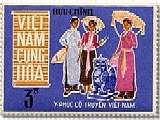 VIETNAM--Part 2
VIETNAM--Part 2 VIETNAM--Part 2
VIETNAM--Part 2In the United States, the "Vietnam War" is a painful part of national history that is familiar to everyone alive at that time and even to most younger people born after the U.S. exited the war.
To the Vietnamese, memories of that "American War" are much more painful.
It is here, after all, that the war was fought, a war that in the words of one U.S. general represented the first "environmental war" directed towards destroying a country's environment. The evidence of that destruction is still visible everywhere, whether in the form of massive and pervasive bomb craters or of flat, open areas that used to be thick jungle. While the Vietnamese have turned much of those "used-to-be-jungle" areas into productive rice fields, a much higher proportion remains unusable, polluted by toxins like the napalm used by the U.S. to set fire to the forest cover in order to make it hard for Viet Cong and north Vietnamese fighters to stay in hiding.
But even such destruction pales in comparison to the destruction done to the people of the country. We in the U.S. properly mourn the loss of over fifty-eight thousand young men and women lost in the fighting. For the Vietnamese, over six HUNDRED thousand soldiers lost their lives -- and even that is a small number next to the unbelievable four MILLION civilians who were killed over the ten years of U.S involvement. Many millions more were disabled as well, and many of those severely so. (These numbers do not include those who were killed in the twelve years prior to 1965 when the Viet Minh of northern Vietnam fought against French forces for their independence.) It is a testimony to the spirit of the Vietnamese people that they were able to endure through such horrors and are now renewing their culture and land, one with thousands of years of history of fighting for independence and maintaining a strong national identity.

A
Statue at the War Remnants Museum in Ho Chi Minh City Is Made of Shrapnel From
Bombs Dropped During the War
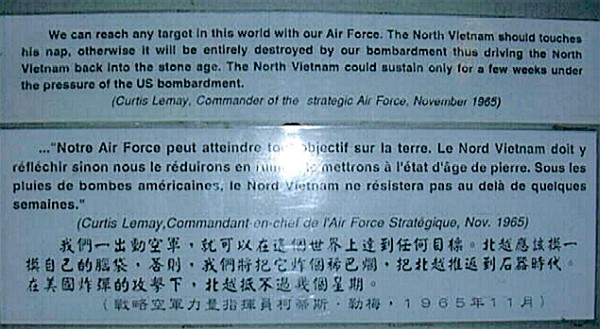
A
Quote By General Curtis LeMay in 1965 Sounds Much Like What the NATO Commanders
Are Saying Today. The U.S. Was Involved in the War for Eight More Years Before
Withdrawing in Defeat. Do We Learn From History?
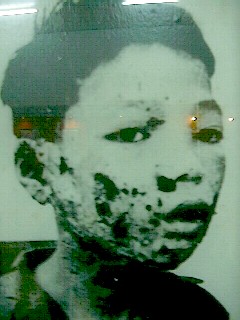
One
Consequence of Napalm Bombing

"Tiger
Cages" Like This Were Kept By the South Vietnamese Government to Hold Viet Cong
Prisoners -- Both Sides Treated Prisoners Terribly (In Other Words: War is Hell)

The
Tunnels at Cu Chi Outside of Saigon Were Used As a Base of Operations for the
Viet Cong in South Vietnam
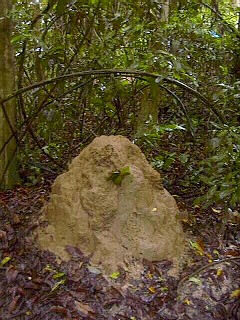
People
Lived Inside the Tunnels for Years, Using Great Ingenuity: This False Termite
Mound Actually Hides an Air Hole Providing Oxygen to the Tunnel Dwellers
|
Walking around and through the Cu Chi tunnels is an eerie experience. Before the wars with the French and the Americans, the area was dense jungle interspersed with villages of people living the traditional lifestyles of rice farmers. The jungle remains, growing back as it always does; the villagers are now returning. It is wet, thick and lush, and it is anything but quiet, with a cacophony of sound created by millions of birds, monkeys and other creatures. (It's the silent ones you know are there that make it a bit scary, though -- we saw a twelve-foot long python being kept as a pet at a nearby restaurant.) During the war, though, the scene was entirely different. I can only imagine what it was like. It took the Viet Cong (supporters in the south of the North Vietnamese "Viet Minh" government) over twenty years to build the system, using woven bamboo shovels to carve out over two hundred miles worth of tunnels from hard red clay. What they created was something an architect would have a hard time dreaming up: virtually an entire city underground, with kitchens and sleeping areas, meeting rooms and storage spaces, all hidden from view and set with booby traps to kill any unwanted intruders. All kinds of systems were used to avoid detection: for example, the tunnel-dwellers washed with the same soap the Americans used, and stuffed shirts from captured American soldiers into vents, to confuse dogs sent to track them. When they cooked, one person had to climb a tree above the cooking area and shake the branches in order to disperse the smoke. The tunnels between the living spaces were tiny, small enough that most Westerners would have a hard time squeezing through -- and thus making the network itself virtually impossible to invade. (On average, Vietnamese people are shorter than Europeans; I stood on a ferry with a few hundred people and, at five-foot-ten, was easily the tallest person.) Indeed, the U.S. ultimately decided that the only way to beat the system was to bomb it from above; this was after the disastrous loss of many lives on trying to invade it by land. The bombing was intense -- we saw one crater from a single bomb that was easily twelve feet deep (even AFTER much of it has been filled in over time by eroded soil) and thirty feet in diameter. Think: the size of your classroom! By the time this bombing did destroy the tunnels, though, the war was nearing its end, and the thousands of Viet Cong who died as a result ultimately accomplished their aim of winning the war. They are viewed as some of the greatest heroes of the war by the modern Vietnamese government, and have been honored by the government in many ways for their efforts and sacrifices. |

The
Secret Tunnel System Was So Effective That the Viet Cong Were Able to Control
This Area Even in the Presence of Massive Numbers of American and South Vietnamese
Armed Forces
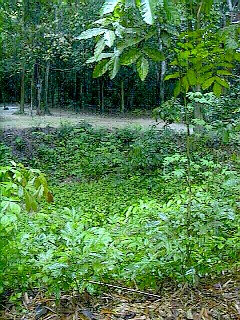
The
Jungle is Growing Back, But This Bomb Crater (Once Twenty Feet Deep) Shows Evidence
of the "Carpet Bombing" Done By U.S. B-52's Attempting to Destroy the Tunnel
System